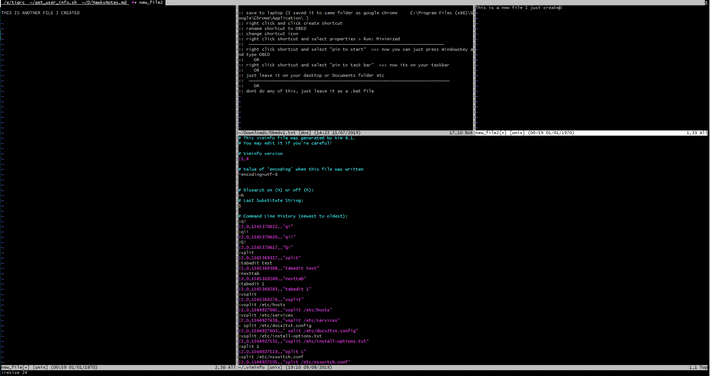How to work with Sessions in Vim
If you regularly work with the same files and tabs open in Vim, Sessions could be your new best friend
📣 For our previous tutorial on how to open multiple tabs in one vim session click here
Using the powers you gained from the tutorial above, lets go ahead and open a few tabs up in VIM ...
and while we're at it, lets do some vsplits and splits to open split windows in one Vim window..
in Vim "escape mode" type
:vsplit <<your_filename_here>>or
:split <<your_filename_here>>to open multiple splits, you can switch between these splits using ctrl w w to cycle through them
You can resize them with the following command
:resize <<number>>Heres a few I opened for this example,
| 👌 We will create another tutorial further explaining splits in Vim soon!
Now... onto these sessions I promised you...
Lets make a session
Now you have all your splits and tabs opened, simply go to "escape mode" by pressing esc and type the following ( replace sessionnamehere with an actual name eg: SeanTest.vim)
:mksession ~/.vim/session/session_name_here.vim👍 TIP: if the ~/.vim/sessions/ directory doesnt exist, you can create it without leaving VIM! heres how, (in "escape mode")
:!mkdir ~/.vim/sessions/and then try the mksession command again
now that we have a session created (you can check it with this command in escape mode)
:!ls ~/.vim/sessions/we can close vim, and go have a cup of coffee...we did it!
Well how do I get that session back?
Oh thats easy... you can do it in one of two ways
- from the command line:
vim -S ~/.vim/sessions/session_name_here.vim- from inside vim (in "escape mode")
:source ~/.vim/sessions/session_name_here.vimand all your tabs and splits are back! woohoo!

So, now try to think which files it would be good to have in a session... for example, all configuration files for your system
- /etc/ntp.conf
- /etc/password
- /etc/groups
- /etc/shadow
- /etc/hosts
- etc etc etc
Today we learned how to open multiple splits and tabs in Vim, how to save these splits and tabs to a session and how to reopen that session at a later time.
If Sean Helped You today, feel free to share this post or connect with us soon, available via gmail, slack or github. Thanks for reading!


